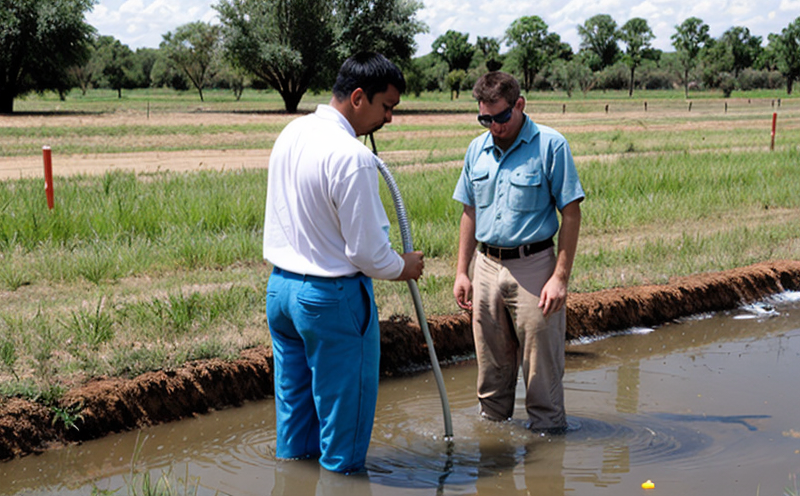ISO 10304-5 Bromide in Groundwater Test
The ISO 10304 series of standards provides comprehensive guidelines for the analysis of various parameters related to groundwaters. The specific focus of this service is on the determination of bromide in groundwater using the methods detailed in ISO 10304-5. Bromide contamination, while not as common as nitrate or phosphate, can be a critical issue depending on local conditions and regulatory requirements.
Bromide testing is essential for environmental monitoring and compliance with various standards, particularly those related to drinking water quality and the protection of aquatic ecosystems. This service ensures that the concentration of bromide in groundwaters meets international safety thresholds set by organizations such as WHO (World Health Organization) and EPA (United States Environmental Protection Agency).
The ISO 10304-5 method is designed to provide accurate, reproducible results that are suitable for both routine monitoring and research purposes. It employs a combination of sample collection procedures, chemical digestion methods, and instrumental analysis techniques to ensure the precision and reliability of the test results.
Sample preparation is critical in this process. Groundwater samples must be collected using appropriate sampling techniques to avoid contamination or degradation of the bromide content. The samples are then transported under controlled conditions to prevent any changes that could affect the test outcomes.
The ISO 10304-5 method involves several steps, including sample digestion, which typically uses a combination of nitric acid and perchloric acid in a microwave digestion system for thorough breakdown. This step is crucial to ensure all bromide compounds are released into solution form before analysis.
Once the samples are prepared, they undergo instrumental analysis using either inductively coupled plasma mass spectrometry (ICP-MS) or ion chromatography (IC). Both methods offer high sensitivity and accuracy necessary for detecting low concentrations of bromide. The choice between ICP-MS and IC depends on laboratory equipment availability and specific analytical requirements.
The method also specifies a series of quality control measures to ensure the reliability of the results. These include the use of certified reference materials, spike recovery tests, and internal standard addition techniques. Regular calibration of instruments using known standards further enhances the accuracy and precision of the measurements.
Following analysis, the laboratory generates detailed reports that provide comprehensive data on bromide concentrations along with associated uncertainties and compliance assessments against relevant regulatory limits. These reports are crucial for stakeholders involved in groundwater management, environmental monitoring, and public health.
The results from this test can have significant implications for various sectors including municipal water supply systems, industrial processes reliant on clean water sources, and agricultural operations that depend on groundwaters. Compliance with ISO standards ensures that these entities can maintain high-quality water supplies while adhering to international best practices.
Applied Standards
The ISO 10304-5 standard is widely recognized and applied in the field of groundwater analysis. It provides detailed protocols for the accurate determination of bromide concentrations, which are essential for ensuring water quality standards are met.
Other relevant international standards that complement this service include:
- ISO 10304-2: Nitrate in Groundwater
- ISO 5667-8: Measurement of Chloride in Water by Ion Chromatography
- ASTM D1129: Standard Test Method for Dissolved Gases in Water by Gas-Chromatographic Techniques
These standards offer a broader framework for comprehensive groundwater analysis, ensuring that the data collected is consistent and comparable across different laboratories and regions.
Benefits
The ISO 10304-5 Bromide in Groundwater Test offers several key benefits to organizations engaged in environmental monitoring, water quality assessment, and compliance activities:
- Achieve Regulatory Compliance: By adhering to internationally recognized standards like ISO 10304-5, businesses can ensure they meet all necessary regulatory requirements.
- Promote Public Health: Accurate bromide testing contributes to the provision of safe drinking water and protection of aquatic ecosystems from potential contamination.
- Enhance Reputation: Demonstrating commitment to environmental stewardship through rigorous testing enhances an organization’s reputation among stakeholders and clients.
- Increase Operational Efficiency: Regular monitoring helps identify issues early, allowing for proactive management of water quality challenges.
- Support Research and Development: Reliable data from ISO-compliant tests can inform new product development or process improvements related to water treatment technologies.
International Acceptance and Recognition
The ISO 10304 series of standards enjoys widespread international acceptance due to their rigorous scientific basis and global applicability. The ISO 10304-5 Bromide in Groundwater Test specifically is recognized by numerous regulatory bodies worldwide, including:
- World Health Organization (WHO)
- European Union (EU) Directives
- American National Standards Institute (ANSI)
The use of these internationally recognized standards ensures that the results from this test are widely accepted and can be used across different jurisdictions, facilitating seamless compliance checks and audits.





